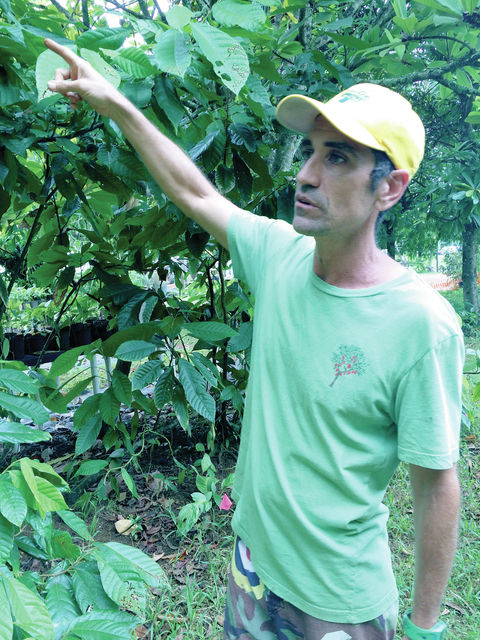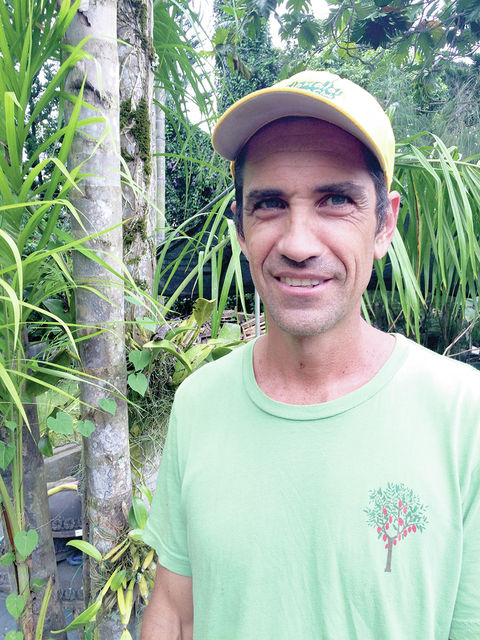Koa Kahili can be likened to Johnny Appleseed, but instead of spreading apples throughout Kauai, Koa has scattered thousands of cacao trees all over the island, and he’s working on more. He has a 30-year-old organic farm in Kilauea, where
Koa Kahili can be likened to Johnny Appleseed, but instead of spreading apples throughout Kauai, Koa has scattered thousands of cacao trees all over the island, and he’s working on more.
He has a 30-year-old organic farm in Kilauea, where he grows dozens of exotic plants. He and his partner, Angela Villa, give three-hour educational tours of their farm and own Garden Island Chocolate, through which they sell locally crafted chocolate bars made with Kauai-grown cacao pods.
Recently Koa sat down with The Garden Island to chat chocolate and sustainable farming.
How did you get into farming?
I grew up in San Francisco and I moved here about 20 years ago. San Francisco was mostly concrete jungle. I wanted to do something that got me away from that. I wanted to get out in nature and farm. It was also a desire to live off the land and not have to go to a store — just to farm and to grow, and then to eat it and cut out all the middlemen. It was a desire to get out in nature and stop civilization and culture from corrupting your mind. Just to go away and get back into the rhythm of why are you alive.
If you’re living off the land you have a direct connection with the land and you’ll be happier and healthier and you’ll appreciate it more. For me, that was my desire, to say how can I use this plant as food and medicine, and there are a lot of plants here that are medicinal plants as well, not just fruit trees.
So, what’s on your farm now?
This is definitely a working farm, on which we even harvest the wild pigs. The pigs will eat the fruits and we’ll harvest the pigs, it’s a whole ecosystem and cycle of life going on here. There’s a lot of critters, it’s a pretty jungle place.
There’s all different kinds of exotic fruits on the place. We have longons, eggfruit, peanut butter fruit, starfruit, cherimoya, vanilla, camellia sinensis — that’s what tea is — and spices. There’s so much out there. What we’re doing here is concentrating on value added fruits — meaning you have to be able to create different products from the one plant. Nobody gets rich in agriculture, so you have to have some kind of value-added product. Sometimes you have to get creative.
It’s all organic — the chickens, rats, bugs. Sometimes we take a huge loss being organic. Sometimes the rats will get 20 percent of the crop, which is huge and I don’t want to put rat poison out. If you just stay on top of when the fruit is ripe, it keeps the rats at bay, but sometimes we go on vacation and there’s a week when you’re not there and you come back and there’s a loss there.
How did you get into making chocolate?
I was doing the farmer’s markets on the island, bringing the exotic tropical fruits. And I was bringing cacao pods to the market, and no one was buying them because nobody knew what they were. They would always ask how you make chocolate out of it, and I wasn’t really sure cause I’ve never done it. I thought, “maybe I should make chocolate.” That was eight years ago.
And then so I started asking around to different farmers to see who had cacao pods and I started networking. That was when I realized that no one was making chocolate on the whole island. People were growing it as a botanical specimen and out of curiosity, but no one was actually taking the time to make chocolate from it.
Then I started realizing that there’s hundreds of tree scattered around the island and the pods were just rotting. Like the jackfruit — no one knows that you can use the seeds; you can roast them like a chestnut or cook them like a potato. So here’s this huge underutilized resource that was going to waste. So, just as a hobby, I said, “let’s just see if I can make a batch.”
I’ve always been into health foods and around that time I had also started eating cacao nibs. That made me feel really good, so I was like, wow, chocolate gives you great energy. So, I started ordering different equipment to make it.
How did that first batch turn out?
That first batch came out just black and rotten. Fermentation is tricky business. So I started talking to people and researching, buying a lot of different chocolate books and putting all the pieces together. After a year I had all the equipment and was able to make a batch of local chocolate and give it to friends and family.
Everyone was blown away. A lot of them had no idea you could even make chocolate on Kauai. I mean, local, Kauai chocolate? Wow. Everyone was really supportive, they said I should make more chocolate. So, I just decided to take a leap of faith and not stop doing what I was doing, which was multimedia and photography, just switch gears and do agriculture and value- added products — just a leap of faith because nobody was doing it.
The main obstacle was, would someone buy a $20 chocolate bar. Everyone was telling me no, that everyone thinks that chocolate is cheap. But, lo and behold when they put them into health food stores they flew off the shelf.
What’s the chocolate- making process like?
It’s a pod and inside it are the beans. So if you eat the bean, it tastes like a bitter lima bean. It has to be fermented. The fermentation process is where you develop the chocolate flavor and the chocolate aroma. After you fermented them, you dry them out and roast them and then grind them.
From the time that you picked the cacao pod off the tree to having a finished chocolate bar it would take about a month and that’s if you’re doing it back-to-back. A lot of times we’ll ferment and dry the beans and hang on to them. Like right now, we’re still going through this past winter’s beans. So coming the winter harvest season, we should be finishing up that previous year’s beans.
You also sell cacao tree starts, right?
I’ve started eight or so varieties and we have hundreds of starts. We sell them or give them away at seed exchanges for the community.
So, if someone tells me they want a cacao orchard in their back yard, I tell them specifically how to do it and years later they’ll have fruiting trees. Then, I guarantee that I’ll buy all the pods back from them, or if they want I’ll teach them how to make chocolate themselves. The entire time I’m holding their hands, and so they come out as chocolatiers — they know how to make chocolate. I have lots of friends all over the island now that are making chocolate for their family and friends. And they are making some really good chocolate.
Over the years I must have started 7,000 or 10,000 plants. And then all the sudden there’s plants floating all over the island, just Johnny Appleseeding all the cacao trees and hopefully people will use them.
What other kinds of educational things do you do?
The main reason for the whole business is to lead the way, not to make money, to say this is how it can be done if future generations chose to do this.
We’re sneaky about this. Sometimes people are pretty resistant to talking about health and eating local and sustainability, but you draw them in with chocolate.
The hook is chocolate, and then once they get here, you get into GMOs and antioxidants, what is organic. You’ve got their attention and interest and can talk about important things with a little sweet treat to eat.
Why stress the need for local, organic, sustainable food?
To be completely honest, it’s not if the food barge to Kauai stops, it’s when. To be dependent on our energy and food from a barge, it’s really unsustainable. You can’t look to the future and say, “Oh, the barge is always going to be here.” No, the economy can shift, anything can happen, and all of the sudden the food barge is going to stop. What are you going to do? It would be nice to have chocolate as part of the local diet. Even though it’s not a traditional Hawaiian Canoe plant, it’s still, in terms of nutrition and yumminess there’s a lot of validity of being sustainable.
Chocolate has been known, for eons, to be a super food and worshiped even in Mezo-America. So it had this really, like, depth to it. If I’m going to plant something, I’m going to plant something that’s going to sustain you spiritually and physically.



